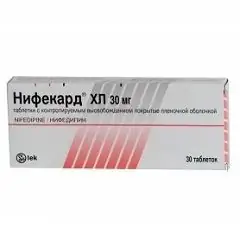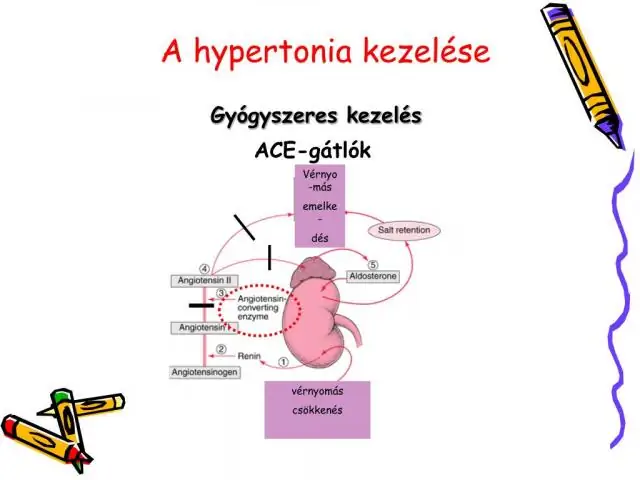- Author Rachel Wainwright [email protected].
- Public 2023-12-15 07:39.
- Last modified 2025-11-02 20:14.
Nifecard HL
Nifecard HL: instructions for use and reviews
- 1. Release form and composition
- 2. Pharmacological properties
- 3. Indications for use
- 4. Contraindications
- 5. Method of application and dosage
- 6. Side effects
- 7. Overdose
- 8. Special instructions
- 9. Application during pregnancy and lactation
- 10. Use in childhood
- 11. In case of impaired renal function
- 12. For violations of liver function
- 13. Drug interactions
- 14. Analogs
- 15. Terms and conditions of storage
- 16. Terms of dispensing from pharmacies
- 17. Reviews
- 18. Price in pharmacies
Latin name: Nifecard XL
ATX code: C08CA05
Active ingredient: nifedipine (Nifedipine)
Manufacturer: Lek d.d. (Lek dd) (Slovenia)
Description and photo update: 2019-21-08
Prices in pharmacies: from 128 rubles.
Buy

Nifecard CL is a calcium channel blocker, a drug with antianginal and antihypertensive effects.
Release form and composition
Dosage form of Nifecard CL - coated tablets with modified release and coated tablets with controlled release: round, convex on both sides, from light brownish yellow to light brownish orange, with an embossed inscription “NDP 30 "(Tablets 30 mg) or" NDP 60 "(tablets 60 mg) on one side (10 pcs. In blisters, 2 or 3 blisters in a cardboard box).
Active ingredient: nifedipine, in 1 tablet - 30 or 60 mg.
Additional substances: sodium lauryl sulfate, magnesium stearate, povidone, magnesium hydrosilicate, Ludipress ® Lek (a mixture of lactose monohydrate, crospovidone and povidone in the ratio 93: 3.5: 3.5), hypromellose (30 mg tablets), hypromellose-2906 and hypromellose -2208 (60 mg tablets).
Shell composition: hydroxypropyl methylcellulose phthalate, polyethylene glycol, hydroxypropyl methylcellulose 2910, hydrous magnesium silicate, hydroxypropyl cellulose, titanium dioxide, triethyl citrate, iron dye yellow oxide NF.
Pharmacological properties
Pharmacodynamics
Nifecard CL has hypotensive and antianginal effects. The active ingredient, nifedipine, is a selective slow calcium channel blocker derived from 1,4-dihydropyridine.
Reduces the flow of extracellular calcium into cardiomyocytes and smooth muscle cells of peripheral and coronary arteries. In high-dose therapy, it inhibits the release of calcium ions from intracellular stores. Reduces the number of functioning channels without affecting the period of their activation, inactivation and restoration.
Nifedipine uncouples excitation and contraction in the myocardium, which are mediated by troponin and tropomyosin, as well as in vascular smooth muscle, associated with calmodulin. When used in therapeutic doses, there is a normalization of the transmembrane current of calcium ions, disturbed against the background of certain pathological conditions, mainly in arterial hypertension. Does not affect the tone of the veins. When using Nifecard CL, coronary blood flow increases, blood supply to the ischemic zones of the myocardium improves without the occurrence of the stealing phenomenon, and the functioning of collaterals is activated.
Nifecard CL improves myocardial function, reduces the force of heart contractions and myocardial oxygen demand. Due to the expansion of the peripheral arteries, there is a decrease in blood pressure, total peripheral vascular resistance and afterload on the heart. Nifedipine has almost no effect on the sinoatrial and AV nodes. It causes moderate natriuresis, enhances renal blood flow, has antiatherogenic properties (especially during a long course).
Other effects of Nifecard CL include inhibition of platelet aggregation, lowering pressure in the pulmonary artery, and a positive effect on the blood supply to the vessels of the brain.
With prolonged use, tolerance to nifedipine may occur.
Pharmacokinetics
After oral administration, nifedipine is absorbed quickly and almost in full (from 92 to 98%).
Due to the sustained release of nifedipine, there is a gradual, controlled increase in its plasma concentrations. Plasma concentration of a substance reaches a plateau in about 6 hours and is maintained for 24 hours with minor fluctuations.
The binding of nifedipine to blood plasma proteins is 90%. It penetrates the blood-brain and placental barrier, excreted in breast milk. Does not cumulate.
Metabolism takes place in the liver. No active metabolites have been identified.
T 1/2 (half-life) of nifedipine is about 2 hours. It is excreted as inactive metabolites mainly in bile and urine (20 and 80%, respectively).
In patients with impaired hepatic function, the clearance of nifedipine decreases; in severe impairments, dose adjustment may be required.
In elderly patients with intravenous administration, the clearance of nifedipine decreases by 33% in comparison with young healthy volunteers.
Indications for use
- Ischemic heart disease: vasospastic (angiospastic) angina pectoris, exertional angina (stable);
- Arterial hypertension.
Contraindications
Absolute:
- Severe stenosis of the aortic valve;
- Severe arterial hypotension (systolic blood pressure below 90 mm Hg);
- Decompensated chronic heart failure;
- Acute period of myocardial infarction (period 4 weeks after the attack);
- Cardiogenic shock;
- Period up to 20 weeks of pregnancy;
- Lactation;
- Hypersensitivity to the components of Nifecard CL or other derivatives of 1,4-dihydropyridine.
Relative:
- Unstable angina;
- Severe stenosis of the aortic orifice or mitral valve;
- Sick sinus syndrome;
- Severe tachycardia;
- Hypertrophic obstructive cardiomyopathy;
- Myocardial infarction with left ventricular failure;
- Malignant arterial hypertension;
- Severe disorders of cerebral circulation;
- Dysfunction of the kidneys and / or liver;
- Age under 18;
- Period from 20 to 40 weeks of pregnancy;
- Simultaneous use of beta-blockers, cardiac glycosides, rifampicin.
Instructions for the use of Nifecard CL: method and dosage
Nifecard CL tablets should be taken orally, swallowed whole, without chewing or breaking.
Treatment begins with a daily dose of 30 mg. If necessary, the dose is increased every 7-14 days.
The maximum permissible daily dose of Nifecard CL is 90 mg.
Side effects
- From the side of the central nervous system: weakness, increased fatigue, headache, drowsiness, vertigo; with prolonged use of high doses - extrapyramidal disorders (shuffling gait, tremors of the hands and fingers, stiffness of the arms and legs, mask-like face, difficulty swallowing, ataxia), anxiety, depression, paresthesia of the extremities;
- From the side of the cardiovascular system: excessive vasodilation (sensation of rushes of blood to the skin of the face, a feeling of heat, hyperemia of the skin of the face, asymptomatic decrease in blood pressure), chest pains, arrhythmia, palpitations, tachycardia, peripheral edema; rarely - syncope, excessive decrease in blood pressure, fainting, angina attacks (more often at the beginning of treatment); in isolated cases - myocardial infarction;
- From the digestive system: dyspeptic disorders (nausea, diarrhea / constipation), decreased appetite, dry mouth; rarely - gingival hyperplasia (swelling, soreness, bleeding); with prolonged use - functional liver disorders (increased activity of hepatic transaminases, intrahepatic cholestasis);
- From the endocrine system: very rarely - weight gain, galactorrhea, hyperglycemia; in the elderly - gynecomastia (completely disappears after the abolition of Nifecard CL);
- From the urinary system: increased daily urine output; in patients with renal insufficiency - deterioration of renal function;
- From the side of hematopoietic organs: thrombocytopenic purpura, thrombocytopenia, leukopenia, asymptomatic agranulocytosis, anemia;
- From the respiratory system: rarely - cough, difficulty breathing; very rarely - bronchospasm, pulmonary edema;
- From the musculoskeletal system: arthritis; rarely - myalgia, joint swelling, cramps of the lower and upper extremities, arthralgia;
- From the side of the organ of vision: very rarely - visual impairment (at the maximum concentration of nifedipine in the blood, transient blindness is possible);
- Allergic reactions: rarely - photodermatitis, exanthema, pruritus, exfoliative dermatitis; in rare cases, autoimmune hepatitis.
Overdose
The main symptoms: peripheral vasodilation with a significant and possibly prolonged decrease in blood pressure (manifested in the form of headache, depression of sinus node activity, facial flushing, bradycardia / tachycardia, bradyarrhythmias), hypoxia, metabolic acidosis, hyperglycemia, cardiogenic shock with the development of edema lungs. In case of severe poisoning, loss of consciousness, coma is possible.
Therapy: carrying out standard procedures for removing nifedipine from the body (taking activated charcoal, gastric lavage), careful monitoring of heart activity, restoration of stable hemodynamic parameters, excretory system and lungs. In case of an overdose with prolonged-release drugs, it is required to ensure the most complete excretion of them from the body. If possible, to prevent further absorption of the active substance, the small intestine is washed. When using drugs with a laxative effect, it should be borne in mind that Nifecard CL can cause a decrease in the tone of the intestinal muscles up to intestinal atony.
Hemodialysis is ineffective, due to the relatively small volume of distribution and a high degree of protein binding, plasmapheresis is recommended. Symptomatic therapy for bradyarrhythmias (beta-sympathomimetics and / or atropine); in the event of the development of life-threatening bradyarrhythmias, a temporary pacemaker is required. With a persistent marked decrease in blood pressure as a result of arterial vasodilation and cardiogenic shock, dopamine (up to 0.025 mg / kg / min), calcium (intravenously 1000-2000 mg of calcium gluconate), dobutamine (up to 0.015 mg / kg / min), adrenaline (epinephrine) or norepinephrine (norepinephrine). Doses of these drugs are determined based on the effect obtained.
In view of the possible volumetric overload of the heart, infusion therapy should be carried out under the control of hemodynamic parameters.
Antidotes - calcium preparations. With impaired hepatic function, the clearance of nifedipine increases.
special instructions
Nifecard CL should be used with caution in the treatment of persons on hemodialysis, patients with high blood pressure, patients with irreversible renal failure, accompanied by a decrease in the total amount of blood, since a sharp drop in blood pressure is possible.
At the beginning of treatment, there is a possibility of angina pectoris, especially after the previous abrupt withdrawal of beta-blockers (therefore, they should be canceled gradually).
The combined use of Nifecard CL with beta-blockers should be carried out under close medical supervision, because an excessive decrease in blood pressure is possible, and in some patients, an aggravation of symptoms of heart failure.
With extreme caution, Nifecard CL should be dosed with severe heart failure.
For patients with vasospastic angina pectoris, this drug is prescribed with the following diagnostic criteria: the presence of a classic clinical picture of the disease with an elevation of the ST segment, the occurrence of spasm of the coronary arteries or ergonovine-induced angina pectoris, detection of coronary spasm with angiography or angiospastic component without confirmation (for example, with different stress threshold or in case of unstable angina pectoris in cases where the electrocardiogram data indicate the development of transient angiospasm).
If it is necessary to perform a surgical intervention during the use of Nifecard CL, it is imperative to inform the anesthesiologist about the therapy received.
During the period of taking Nifecard CL, it is possible to obtain positive results when conducting laboratory tests for the determination of antinuclear antibodies and when conducting a direct Coombs reaction.
Patients with impaired liver function during therapy should be under close medical supervision (if necessary, the dose of nifedipine should be reduced and / or other dosage forms of this substance should be used).
Patients with severe obstructive cardiomyopathy are at risk for an increase in the frequency, duration and severity of angina attacks after taking Nifecard CL.
Cancellation of Nifecard CL should be gradual.
Influence on the ability to drive vehicles and complex mechanisms
During treatment, care must be taken when driving vehicles and performing potentially hazardous types of work that require increased attention and high reaction rates.
Application during pregnancy and lactation
- period up to 20 weeks of pregnancy, breastfeeding (lactation): Nifecard CL is contraindicated to take;
- the period from 20 to 40 weeks of pregnancy: therapy should be carried out under medical supervision, provided that the expected benefit outweighs the possible risk; the drug should be used only in stationary conditions under appropriate monitoring of the condition of the mother and the fetus, including monitoring the mother's blood pressure and regular ultrasound monitoring of the viability and development of the fetus; when anomalies are detected, Nifecard CL is canceled.
Pediatric use
Therapy with Nifecard CL is contraindicated in patients under 18 years of age.
With impaired renal function
Nifecard CL tablets with impaired renal function should be used with caution.
For violations of liver function
According to the instructions, Nifecard CL should be used with caution in case of impaired hepatic function.
Drug interactions
- Other antihypertensive drugs, beta-blockers, inhalation anesthetics, tricyclic antidepressants, diuretics, nitrates, cimetidine, to a lesser extent ranitidine: the antihypertensive effect of nifedipine is enhanced;
- Quinidine: its concentration in blood plasma decreases, and after the abolition of nifedipine, a sharp increase in the level is possible;
- Digoxin, theophylline: their concentration in the blood plasma increases (it is necessary to control the concentration in the blood and the clinical effect);
- Inducers of microsomal liver enzymes (including rifampicin): the concentration of nifedipine decreases;
- Nitrates: tachycardia intensifies;
- Non-steroidal anti-inflammatory drugs, calcium preparations, sympathomimetics, estrogens: the antihypertensive effect of nifedipine decreases;
- Vincristine: its excretion slows down, side effects increase (its dose must be reduced);
- Lithium preparations: the toxic effects of lithium are enhanced (nausea, vomiting, diarrhea, tremor, ataxia, tinnitus);
- Cephalosporins (for example, cefixime): increases the bioavailability of cephalosporin by 70%;
- Drugs characterized by a high degree of protein binding (anticonvulsants, non-steroidal anti-inflammatory drugs, salicylates, coumarin, quinine, sulfinpyrazone, indandione): their concentration in blood plasma increases.
Grapefruit juice inhibits the metabolism of nifedipine in the body, therefore its simultaneous administration with Nifecard CL is contraindicated.
Analogs
Analogs of Nifecard CL are: Adalat, Zanifed, Calcigar Retard, Kordafen, Kordipin CL, Kordipin retard, Kordaflex, Nifedipin.
Terms and conditions of storage
Store at temperatures up to 25 ° C. Keep out of the reach of children.
The shelf life is 3 years.
Terms of dispensing from pharmacies
Dispensed by prescription.
Reviews about Nifeckard HL
In reviews of Nifecard CL, patients characterize the drug as effective, high-quality and easy to use, well reducing and stabilizing pressure.
The main disadvantage is the relatively high cost.
Price for Nifecard CL in pharmacies
Approximate price for Nifecard HL:
- package of 30: 30 mg tablets - 180-189 rubles, 60 mg tablets - 257-323 rubles;
- package 60 pieces: 30 mg tablets - 323-383 rubles, 60 mg tablets - 462-573 rubles.
Nifecard HL: prices in online pharmacies
|
Drug name Price Pharmacy |
|
Nifecard HL 60 mg film-coated tablets with controlled release 30 pcs. RUB 128 Buy |
|
Nifecard HL tablets p.o. with mod. release 30mg 30 pcs. 161 r Buy |
|
Nifecard HL 30 mg film-coated tablets with modified release 30 pcs. 161 r Buy |
|
Nifecard HL 30 mg film-coated tablets with modified release 60 pcs. 309 RUB Buy |
|
Nifecard xl tab. with mod. exs. p / o film. 30 mg No. 60 RUB 315 Buy |
|
Nifecard HL 60 mg film-coated tablets with modified release 60 pcs. 509 RUB Buy |

Maria Kulkes Medical journalist About the author
Education: First Moscow State Medical University named after I. M. Sechenov, specialty "General Medicine".
Information about the drug is generalized, provided for informational purposes only and does not replace the official instructions. Self-medication is hazardous to health!






